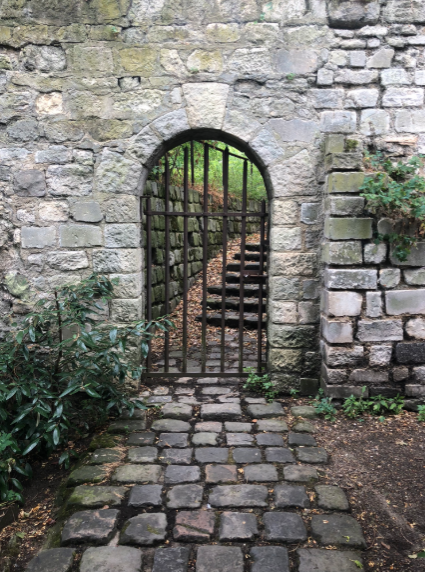Reality and Art for the Dawn of a new Era
Article by Micah Tinklepaugh
Art is a weapon. It breaches our minds to reveal mismatches between what the world is and what it could be. But what keeps art’s blade sharp? This article reviews some methods and tools that kept art in a continual flux. It touches on why video installations may just be a precursor to deeper immersion for the viewer and presents a call to arms for artists to create pieces that categorically challenge museums everywhere.

// In the beginning…

The first realistic paintings of sunsets and people were breathtaking and shocked people into not only marveling at photo-realism but also reflect inwardly about the part the play on humanity’s stage. But in today’s world, we are inundated with photo shopped images steeped in visual hyperbole, a perpetual utopia. ‘Good enough’ art is within reach for much of the population by just walking down the streets of Paris where paintings impress people enough to make them stop and look. Not every painting in the Louvre can do that.
Some of the population doesn’t get excited by art. Many of us feel intimidated by our lack of knowledge or underwhelmed by the inability of the art to engage our senses or even convey meaning. So I ask the question, have our institutions taught my generation of artists the proper perspective? Are they giving them the tools they need to succeed? In either case, the concept of the art museum is ready for an awakening. Many art museum exhibits mostly consist of flat walls with paintings that are either photo-realistic, blurred, abstract or some combination.
Some artists have attempted to use new tools and methods in the last few decades by creatively installing video exhibits. A problem with this is that they may never be as natural as a 2D image on a 2D wall in a museum because most of the perceptual cues in the video will never be congruent with the perceptual cues in the viewer’s cognitive frame of reference. Everything in a 2D painting, like the wall, is frozen and static as depicted in figure 1 (a). Even if motion is implied, it is usually left to the viewer to imagine.
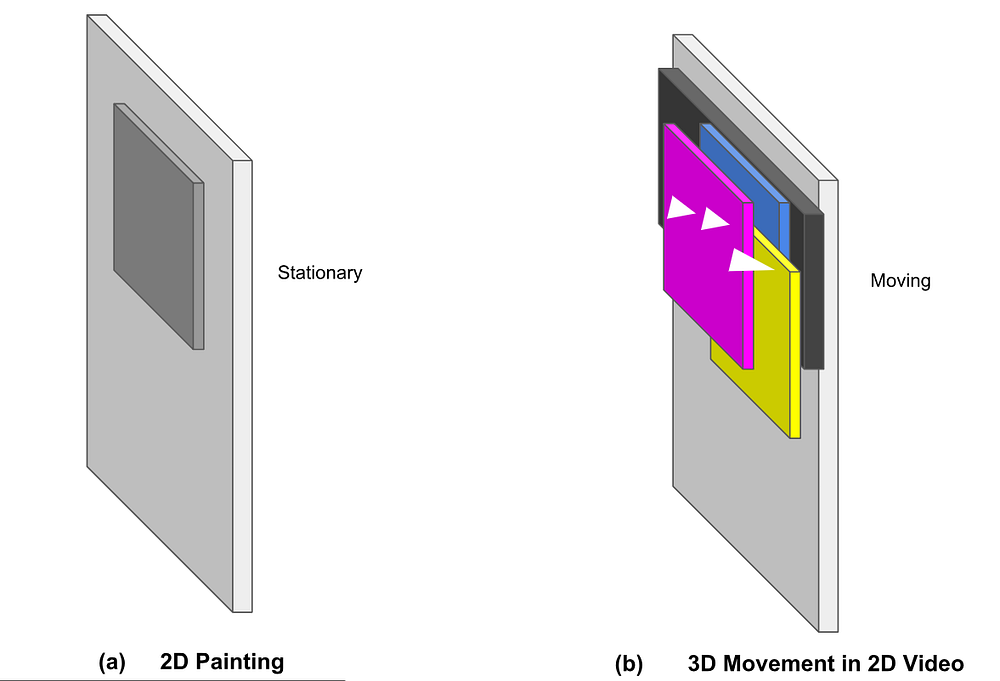
In Figure 1(b), the black medium represents a television with boxes representing moving elements within a scene. These elements are moving not only from side to side and from top to bottom but also starting close to us to further away, or vice versa. The movement does not match the viewers reference frame. For more examples check out some spatial interface principles I helped write at Meta Co with the chief neuroscientist, VP of Design, and CEO.
Even if the television were suspended from a ceiling, it will still be in-congruent to the way humans sense the world, motion, and other perceptual cues that they associate with 3D objects. Some artists are able to use space and light to their advantage, such as the unnamed artist in figure 2. This image was taken in a MIT gallery and features an array of television sets. But this may be as profound as it gets because there are only so many patterns in which you can arrange boxes (tvs) inside a box (room).
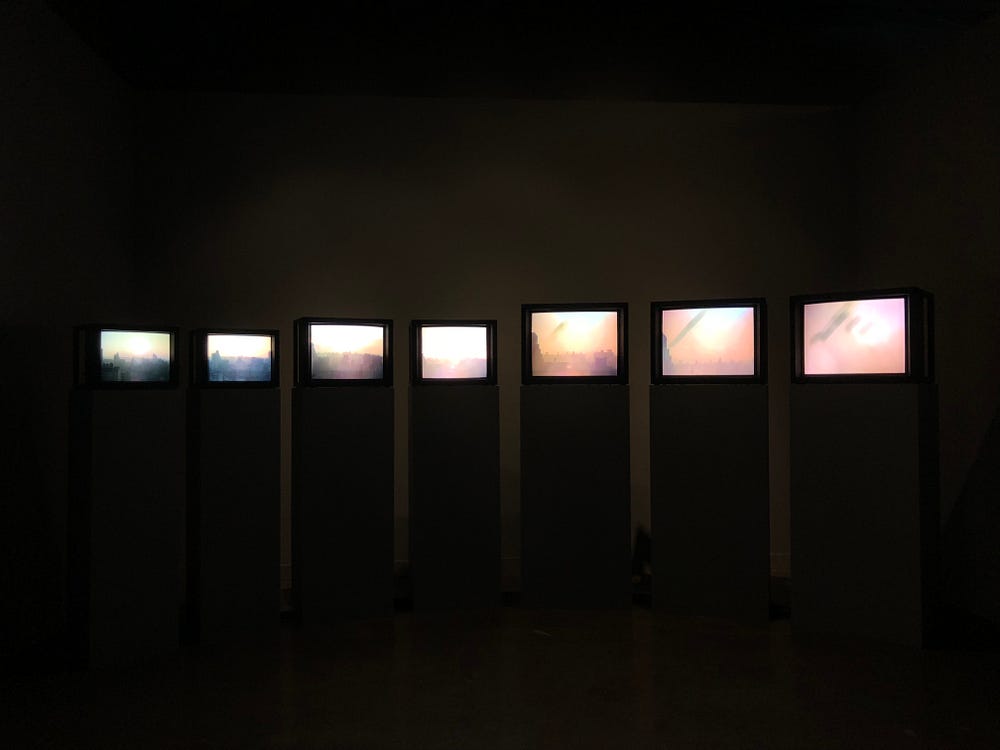
Art is typically most powerful when it opens our minds to mismatches in the world that we have never seen and that potential may be diminished if we are too distracted by the mismatch between the art and our physical surroundings.
Sculpture goes a long way in diminishing the mismatch between dimensional motion of the backdrop or wall and that of the medium mostly because the backdrop is the subject and there is no wall. There is little mismatch between 2D and 3D visual cues and contexts. But it is still static. It is still an old tool and lacks the transient qualities of paintings both in content and physical instantiation. For instance, Rodin sculpts the gates of hell — a seemingly more permanent concept than starry night — a painting by Van Gogh.
// Where are today’s art rebels?
I was in Montemartre, Paris the other day where some of the world’s finest impressionists spent some of their time exchanging ideas. I was hoping to be swept up in inspiration. Below in figure 3 is a vineyard where impressionists had made painted famous works that dazzled and provoked our great great grand mothers and great great grand fathers.
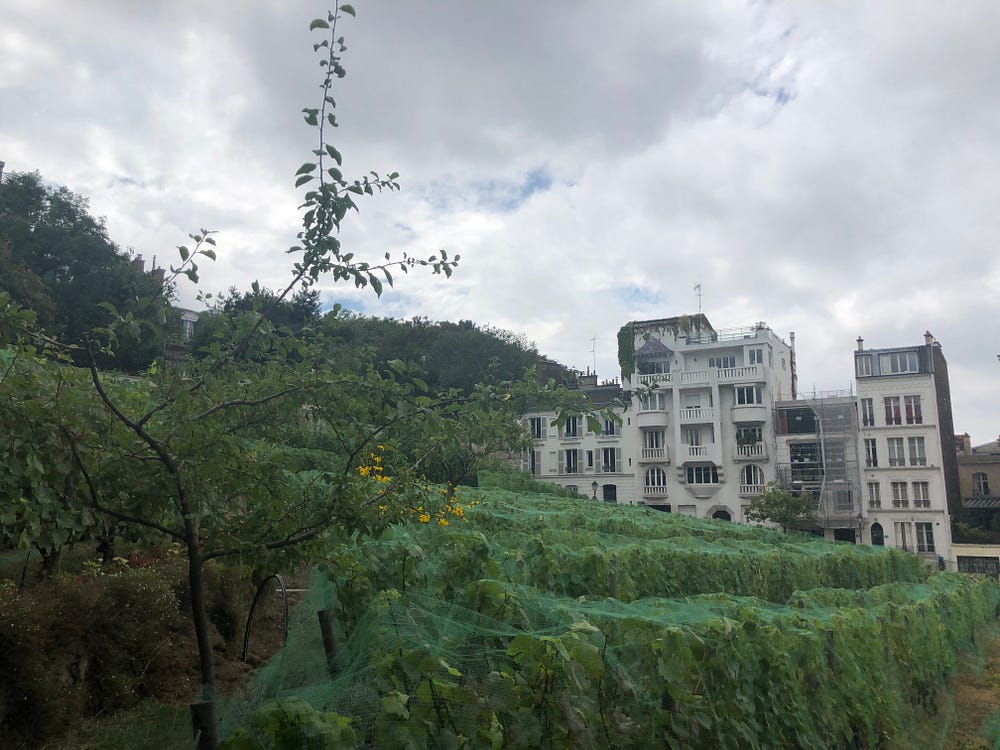
After looking around Renoir’s stomping grounds, my plan was to immediately visit contemporary art sections of Centre Pompidou, Fondation Cartier pour ‘Art Contemporain, and the Musee de Modern Art. However, I’ve been to see some contemporary art in San Francisco, New York, Frankfurt, and it struck me that unless I understand the subtleties of fine art and modern art, contemporary art may never strike me. Is this because contemporary art uses bits and pieces of its predecessors while couching itself as rebellious? I’m not educated enough to say. But I feel very underwhelmed by it and I spend a fair amount of time exposing myself to it.
Then I realized that if contemporary art doesn’t strike me, it may not strike anyone who does not possess intuition for art — or an advanced and expensive degree.
If artists wants to rebel against the norms of the current art world, they have to do more than just arrange perceptual cues in new patterns or use old tools in new ways — they have to use new tools in new ways.
There is something very wrong with just using old methods and tools in new ways. It is quite literally, blasé. The whole reason people were shocked by paintings were because they were seeing a new message presented in a new and never experienced way.
// Art rebels used old weapons in new ways.
Not everybody in centuries past could travel as much as the average person today. Travel hasn’t always been as prevalent. A realistic painting or impressionist painting shattered their present reality. It ‘blew their minds’. Even expressionist painting and some modern paintings did this. But there is a law of diminishing returns. Humanity is habituating.
I don’t believe that impressionists like Manet, Renoir, Monet, or Van Gogh would be with today’s emphasis on subtlety and remixing century or even decade old techniques. They were rebels. They would rebel against what is happening today. They used brush strokes in new ways and thereby weaponized the conventional tools of the previous generation by showing new aspects of reality than just making every painting photo-realistic. This was using an old tool in a new way. But this ground was broken a long time ago. It may not be enough to mix collages, abstract expressionism, cubism, or any technique from the last fifty years or even two centuries to communicate the mismatches the artist sees in reality to an audience who has become desensitized to the mediums.
This places a mandate on art museums to be more than a place where the most educated art historians go to help us remember and pay homage to people who made art. We see some museums nodding their head to rebels but not nearly enough.
// What are the requirements for a new art weapon?
Transience is an important part of art not just in the content but also the ability to transmit that content. Paintings have worked so well because they were able to be moved and they are able to move the viewer.
But the world is no longer swept away by these 2D experiences and we have televisions at home. So, unless we are intrinsically motivated by subtleties of human perception and art techniques, then the greatest works of tomorrow’s artists may go unnoticed.
Great art has always been transient and easy to transmit. Until today, it’s ability to immerse us has been limited. We should look at how successful artists have done this with their art — instead of just looking at the art itself.
Perhaps one of the most powerful types of images was the lithograph, mixing water and grease to make multiple prints on paper with a stone (layman’s definition). This was effective because art could be mass produced. Lithographs live in the Museum and outside of it. I’d argue it wasn’t Toulouse-Lautrec’s ability alone that put him in touch with elite artists in Montemartre but his clever acquisition of lithographic methods that constrained his style and forced him to employ simplicity in visually representing highly sensory experiences of burlesques for the bourgeois. In figure 4 we can see Lautrec using simple lines and a handful of colors that enabled the mass printing of his art. The art is fun — it is a bunch of people drinking and dancing in a burlesque.

// What is a new art weapon for today?
What is the lithograph of today? Stereo-graphic headsets that create 3D spatial illusions from overlapping similar moving images and presenting them to both eyes. This method is commonly called augmented and virtual reality and given the misnomer ‘Hologram’ by one of the largest technology firms of 2018, Microsoft. This stereogram (or Hologram if you are in Microsoft Marketing department) takes the best parts of sculpture and video in that it tells a story, changes, and occupies depth in the visual human field but lacks the awkwardness of sticking 2D panes of glass in an exhibit.
Augmented Reality (‘Hologram’) overlays information in the viewer’s visual field relative to their surroundings.
Mixed Reality (‘Hologram’) overlays information and replaces some but not all of the contents of their visual field, relative to their surroundings.
Virtual reality replaces all of the contents of their visual field not relative to their surroundings.
Below is the concept of what a stereogram looks like. When wearing a headset , it is something you can see rest on your kitchen table.

Below are some holographic designs of three major stereographic headset makers Microsoft, Meta, and Magic leap, respectively. Apple has yet to produce a headset, so they are left out of the equation, for now.

The reader can see how this artistic medium blows 2D paintings and sculptures out of the water and may agree that some of the impressionists would have used this art weapon if they could have. The only museum I’ve seen do an exhibition at all is Boston Institute of Contemporary Art. Other museums have done them, such as the Louvre, but I’ve not had the benefit of experiencing them.
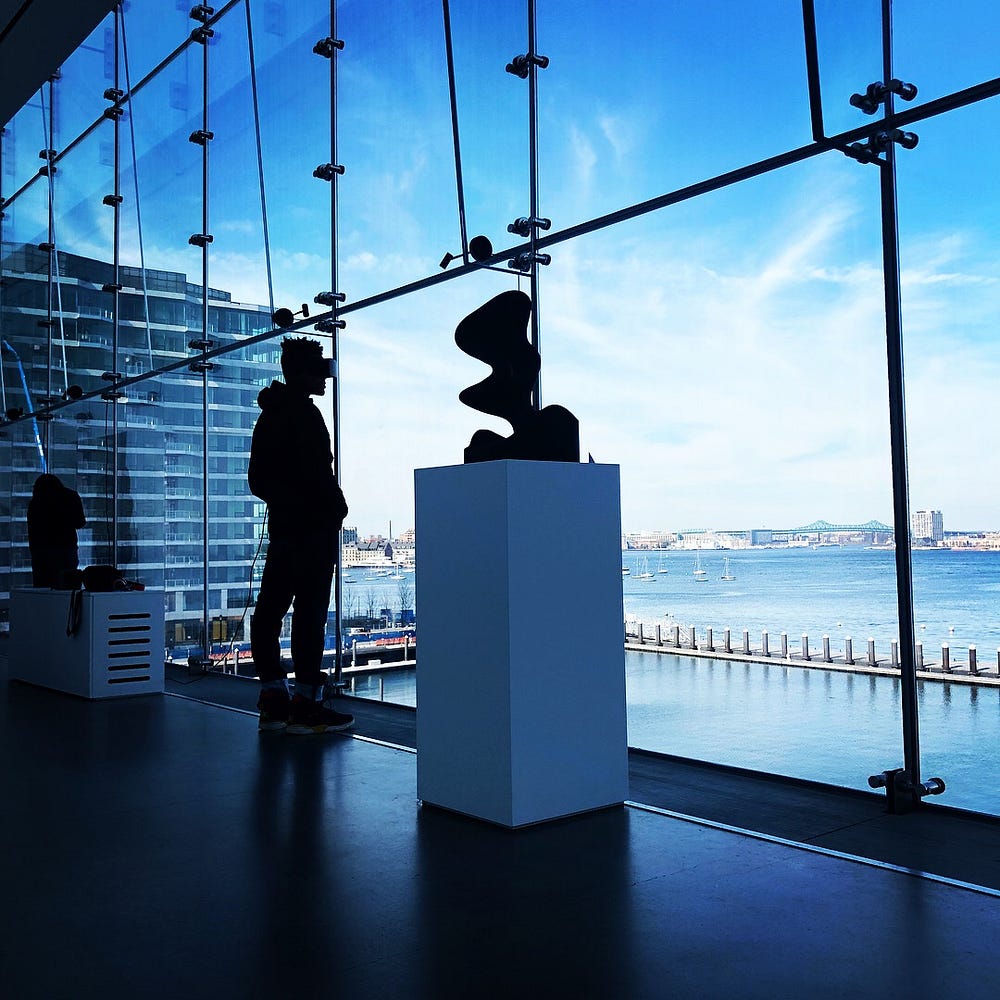
// How are these weapons being used?
I’ve been on a year long journey to find art that evokes stereography or ‘holograms’. One example of old cinematography techniques being used in novel ways was in an installation by Anna Craycroft, that moved light across the surfaces of simple shapes. ‘Holograms’ (patterns of interference) are made of simple junction of vertices, lines, and edges. Then they are wrapped with a material and texture. Finally, they get illuminated with a light source. Craycroft does these things.
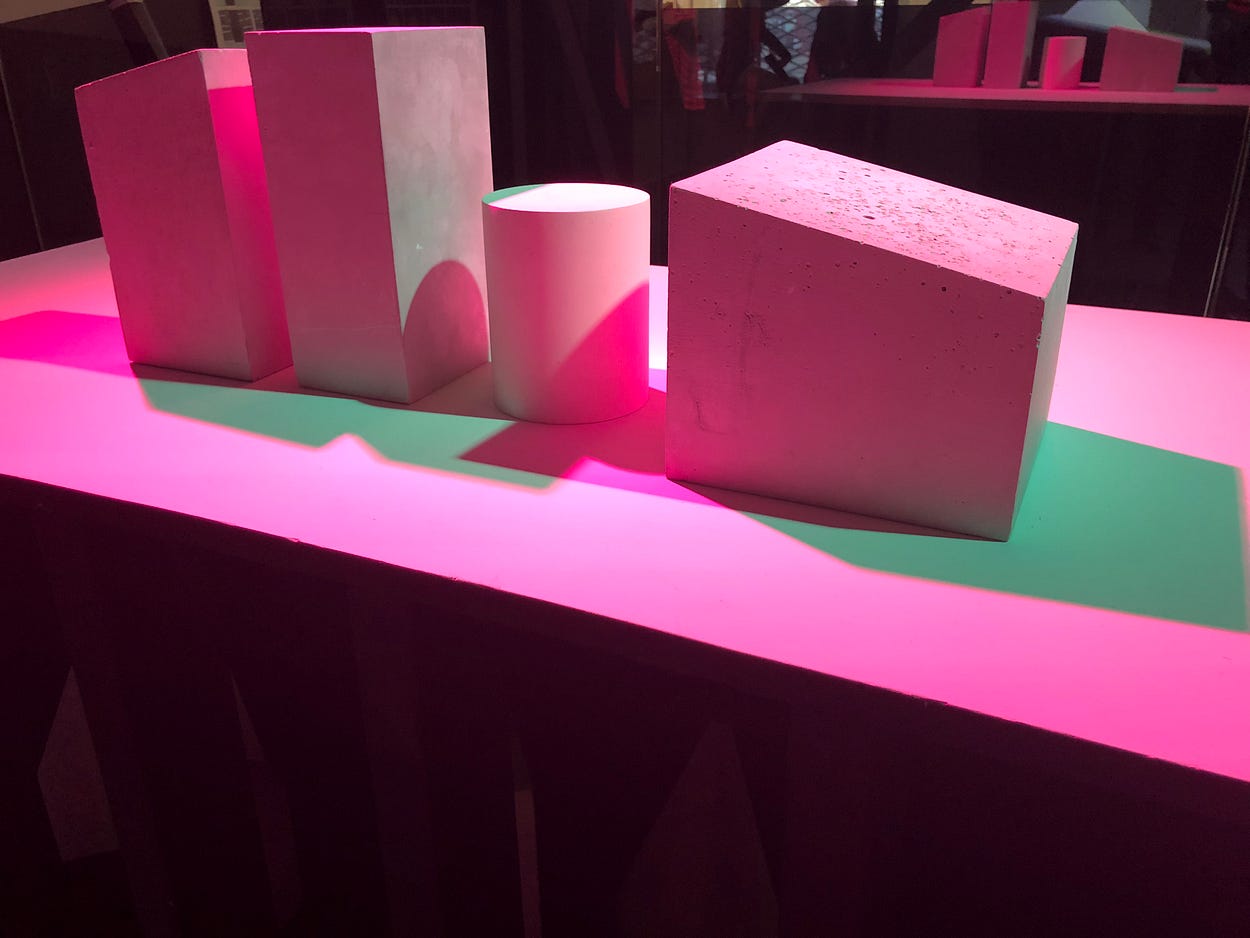
Anna Craycroft’s work has pushed the limits into helping artists understand what the essence of a hologram is(whether or not she intended that) but by far the person who has taken ‘hologram-esque’ the farthest is Salvador Dali. He sculpted the mobius strip below, a curved one dimensional plane occupying multiple dimensions.

Again, this is an old tool of sculpture but being used in a new way. No one would say that Dali had the intention of purposing the strip as a hologram but no one can say he didn’t since the essence of surrealism is to not force meaning into the experience of the art viewer. To many, this piece uses shape and form to express aspects of higher mathematical dimensions — a perspective that maybe used to explain the very reason holograms would exist.
One big purpose of the ‘hologram’, and any visual language or medium, is to communicate shared understanding so that humanity can continue to do meaningful things such as explore mars or quantum mechanics, or help a princess far far away.
Brave scientific inquiry has typically required advances in art whether that was Descartes juxtaposing lines and dots to create his coordinate system or Martin Newell creating a digital collection of points in space that would form the Utah Teapot.
Anna Craycroft and Salvador Dali have blazed trails in conventional mediums of mixing light and objects to attain new intellectual heights. They use older tools in new ways, with Crayfcroft using animations concepts and tools of the 1900’s in very new ways.
But for an example of someone using virtual reality today, we turn Zach Kinster, who made a visual tool in VR called Exa, that allows users to intuitively make music. This is a new tool being used in a new way.
For an example of someone doing fine arts work within Virtual Reality, we look at Anna Zhilyaeva’s work with a symphony and at the Louvre. Zhilyaeva uses a new tool to make 2D art 3D with an entirely new aesthetic — and this is just the tip of the iceberg. Imagine peering into her sketch book.
To interact with the piece yourself, visit Google Poly where you can explore it on your PC and in VR.
Tech companies are gaining ground on the Museum
The museum is now extensible to a place we can find in a headset. It can be viewed from the Louvre or a trailer home, making it accessible to a wider audience.
This is profound because transience for the sake of transmission are in part what make museums successful.
Some of this new museum is in a technology store like Facebook, Google, Apple and Microsoft, companies that build virtual infastructure and or provide places where we can see their worlds to which these products serve as portals. They add small tables to rooms evoking a museum. The tables in the stores hold the headset portals that help us peer into new worlds.
These corporations are the new wealthy patrons of the arts. They are poised in a place to collect the works of 3D artists on their platform. We love them for this the way our predecessors did the aristocrats like Orsay who stockpiled art.
If you do get a chance to visit Montemartre, there is a small locked iron wrought door that is particularly profound. To me it symbolizes parts, not the whole, of an art world that in trying to recreate sentiments with old techniques and tired tools of its past, and in so doing, has barred itself from its future.
